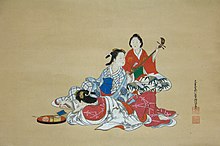Nishikawa Sukenobu

Nishikawa Sukenobu (西川 祐信, 1671 – August 20, 1750), often called simply "Sukenobu", was a Japanese printmaker from Kyoto. He was unusual for an ukiyo-e artist, as he was based in the imperial capital of Kyoto. He did prints of actors, but gained note for his works concerning women. His Hyakunin joro shinasadame (Appreciating 100 women), in two volumes published in 1723, depicted women of all classes, from the empress to prostitutes, and received favorable results.
Life and career

Nishikawa Sukenobu was born in Kyoto in 1671 and studied painting there under Kanō Einō of the Kanō school of painting; he may also have studied under Tosa Mitsusuke of the Tosa school. Sukenobu's earliest known works are book illustrations that date to 1699; the earliest signed in his name is the seven-volume Shin Kanninki ("New patience story"). While most ukiyo-e artists were based in Edo (modern Tokyo), Sukenobu spent his career in Kyoto.[1]
Sukenobu specialized in depictions of female beauties from different classes in their daily lives. He also produced books of kimono patterns, Musha-e portraits of warriors, illustrations of classical literature, and paintings.[1]
Sukenobu died in Kyoto on 20 August 1750. He was also known under the names Uemon, Jitokusō, Jitokusai, Bunkado, Ukyō, Saiō. The influence of his style of depicting women is seen in the works of such artists as Suzuki Harunobu and Kitao Shigemasa.[1]
Collections
Sukenobu's work is held in the permanent collections of several institutions, including the Dallas Museum of Art,[2] the Carnegie Museum of Art,[3] the Indianapolis Museum of Art,[4] the Harvard Art Museums,[5] the University of Michigan Museum of Art,[6] the Seattle Art Museum, the Suntory Museum of Art,[7] the Metropolitan Museum of Art,[8] the Brooklyn Museum,[9] the Museum of Fine Arts, Boston,[10] and the Philadelphia Museum of Art.[11]
References
- ^ a b c Matsudaira.
- ^ "Geisha in Summer - DMA Collection Online". www.dma.org. Retrieved 2021-07-02.
- ^ "CMOA Collection". collection.cmoa.org. Retrieved 2021-07-02.
- ^ "None". Indianapolis Museum of Art Online Collection. Retrieved 2021-07-02.
- ^ Harvard. "From the Harvard Art Museums' collections Nishikawa's Comparison of Warriors (Nishikawa musha-kurabe)". harvardartmuseums.org. Retrieved 2021-07-02.
- ^ "Exchange: Courtesan on Promenade: left page of a two-page book llustration". exchange.umma.umich.edu. Retrieved 2021-07-02.
- ^ "Collection Database". SUNTORY MUSEUM of ART. Retrieved 2021-07-02.
- ^ "Picture Book of Mount Asaka (Ehon Asakayama)". www.metmuseum.org. Retrieved 2021-07-02.
- ^ "Brocade Making by Women". www.brooklynmuseum.org. Retrieved 2021-07-02.
- ^ "Genre Scenes in the Four Seasons". collections.mfa.org. Retrieved 2021-07-02.
- ^ "A Courtesan Listening to the Singing of a Woman with a Girl Playing the Samisen". philamuseum.org. Retrieved 2021-07-02.
Works cited
- Matsudaira, Susumu. "Nishikawa Sukenobu". Grove Art Online, Oxford Art Online. Oxford University Press. Retrieved 2015-04-10.
External links
- Artnet: Nishikawa Sukenobu
- Nishikawa Sukenobu by Honolulu Museum of Art
- The Shunga of Nishikawa Sukenobu by Honolulu Museum of Art
- v
- t
- e

of 17–19th centuries
- Asayama school
- Eishi school
- Furuyama school
- Harukawa Eizan school
- Harunobu school
- Hasegawa school
- Hishikawa school
- Hokusai school
- Ippitsusai Bunchō school
- Ishikawa Toyonobu school
- Kaigetsudō school
- Katsukawa school
- Kawamata school
- Keisai Eisen school
- Kitagawa school
- Kitao school
- Miyagawa school
- Nishikawa school
- Nishikawa Sukenobu
- Nishimura school
- Okumura school
- Ōoka school
- Osaka school
- Ryūkōsai school
- Shigenobu school
- Shunkōsai Fukushū school
- Torii school
- Toyohara school
- Utagawa school
- Utagawa Toyoharu
- Utagawa Toyohiro
- Utagawa Toyokuni I
- Utagawa Kunimasa
- Utagawa Kunisada
- Utagawa Kunisada II
- Utagawa Kunisada III
- Utagawa Sadahide
- Utagawa Kunimasu I
- Utagawa Toyokuni II
- Utagawa Kuniyasu
- Utagawa Kuniyoshi
- Ryusai Shigeharu
- Utagawa Yoshitsuya
- Utagawa Yoshitora
- Kawanabe Kyōsai
- Utagawa Yoshiiku
- Utagawa Yoshitoshi
- Utagawa Yoshifuji
- Utagawa Kuniteru I
- Utagawa Hiroshige
- Utagawa Hiroshige II
- Utagawa Hiroshige III
- Utagawa Hirokage
- Utagawa Sadafusa
- Adachi Ginkō
- List of Utagawa school members
- Not associated with any school
artists and movements
- Shin-hanga
- Sosaku-hanga
- Azechi Umetarō
- Eiichi Kotozuka
- Un'ichi Hiratsuka
- Itow Takumi
- Kitaoka Fumio
- Yasuhide Kobashi
- Sakuichi Fukazawa
- Masao Maeda
- Senpan Maekawa
- Maki Haku
- Matsubara Naoko
- Yoshitoshi Mori
- Shikō Munakata
- Tetsuya Noda
- Gihachiro Okuyama
- Kōshirō Onchi
- Kiichi Okamoto
- Saitō Kiyoshi
- Sekino Jun'ichirō
- Toko Shinoda
- Hiroyuki Tajima
- Sadao Watanabe
- Kanae Yamamoto
- Shōzaburō Watanabe
- Hodaka Yoshida
- Tōshi Yoshida
- Suwa Kanenori
- Fujimori Shizuo
- Reika Iwami
- Tadashige Ono
- Chosei Kawakami
- Others
- Kohno Michisei
- Tadashi Nakayama
- Fujio Yoshida
- Japanese painting
- Rinpa school
- Kanō school
- Akita ranga
- Hara school
- Hasegawa school
- Kyoto school
- Nanpin school
- Nanga
- Nihonga
- Shijō school
- Yōga
- Ukiyo-e influenced non-Japanese art
- Japonisme
- Japonaiserie (Van Gogh)
- Impressionism
- Anglo-Japanese style
- Post-impressionism
- Art Nouveau
- Ligne claire













